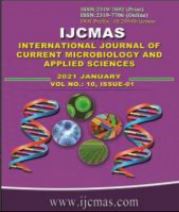


 National Academy of Agricultural Sciences (NAAS)
National Academy of Agricultural Sciences (NAAS)

|
PRINT ISSN : 2319-7692
Online ISSN : 2319-7706 Issues : 12 per year Publisher : Excellent Publishers Email : editorijcmas@gmail.com / submit@ijcmas.com Editor-in-chief: Dr.M.Prakash Index Copernicus ICV 2018: 95.39 NAAS RATING 2020: 5.38 |
Vaginal symptoms and urinary tract infection are one of the most common reasons for gynecological consultation. Despite the differences between the organism that cause vaginitis and UTI, it is possible that women having vaginitis develop UTI. The main objective of this study was to find the association of the common types of infectious vaginitis with UTI. A study was conducted among women of reproductive age attending outpatients of Gynaecology and Obstetrics department of National Medical College Teaching Hospital, Birgunj, Nepal. The study was conducted from August 2019 to July 2020. Among 400 females, 118 were pregnant and 282 were non pregnant women .Out of 400women, 134 (33.5%) had vaginitis and among them 49.3% had Bacterial vaginitis (BV), 40.3% had Vulvovaginal candidiasis (VVC) and 10.7% had mixed infection (both BV and VVC). There were no any cases of Trichomoniasis. In the study, women of age group 21-30 were most infected (68.7%), (p=0.117). Among 400 urine sample processed, 58 (14.5%) had UTI with 21-30 age group being the most prevalent, 55.17%. Altogether 4 different bacterial species were isolated among which E. coli was most predominant gram negative organism and Staphylococcus aureus being the only gram positive organism. All gram negative organisms were sensitive towards Nitrofurantoin and gram positive were sensitive to Gentamicin. A strong association was revealed between vaginitis and UTI (p=0.000), Candida and UTI (0.003) but association between BV and UTI was statistically insignificant (p=0.231).
 |
 |
 |
 |
 |